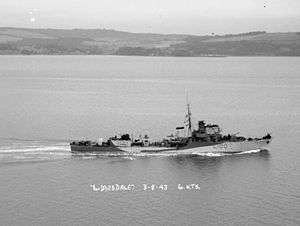HMS Liddesdale (L100)
HMS Liddesdale was a Type II Hunt-class destroyer of the Royal Navy built by Vickers-Armstrong in Newcastle and launched on 19 August 1940. She was laid down on 20 November 1939 and commissioned 28 February 1941. She served as a convoy escort in the Mediterranean Sea.[1][2][3]
 HMS Liddesdale | |
| History | |
|---|---|
| Name: | Liddesdale |
| Ordered: | 4 September 1939 |
| Builder: | Vickers-Armstrong (Newcastle-on-Tyne, U.K.): Parsons |
| Laid down: | 20 November 1939 |
| Launched: | 19 August 1940 |
| Commissioned: | 28 February 1941 |
| Out of service: | Sold in 1948 |
| Identification: | pennant number: L100 |
| Fate: | Scrapped in 1948 at Gateshead |
| General characteristics | |
| Class and type: | Hunt-class destroyer |
| Displacement: |
|
| Length: | 85.3 m (279 ft 10 in) o/a |
| Beam: | 10.16 m (33 ft 4 in) |
| Draught: | 3.51 m (11 ft 6 in) |
| Propulsion: |
|
| Speed: |
|
| Range: | 2,350 nmi (4,350 km) at 20 kn (37 km/h) |
| Complement: | 168 |
| Armament: |
|
War service
HMS Liddesdale served as a convoy escort based from Malta for the majority of World War II. On 21 May 1944, Liddesdale, alongside the destroyers Termagant and Tenacious sank U-453 using depth charges off the south coast of Italy.[1]
Sources
- Colledge, J. J. & Warlow, Ben. Ships of the Royal Navy - The Complete Record of all Fighting Ships of the Royal Navy from the 15th Century to the Present. Casemate. ISBN 978-1-935149-07-1.CS1 maint: multiple names: authors list (link)
- English, John (1987). The Hunts - A history of the design, development and careers of the 86 destroyers of this class built for the Royal and Allied Navies during World War II. Cumbria: World Ship Society. ISBN 0-905617-44-4.
- Whitley, M. J. (1988). Destroyers of World War Two - an international encyclopedia. London: Arms and Armour. ISBN 0-85368-910-5.
- Gardiner, Robert (1987). Conway's All the World's Fighting Ships 1922-1946. London: Conway Maritime Press. ISBN 0-85177-146-7.
References
- "HMS Liddesdale (L 100)". uboat.net.
- "HMS Oakley, escort destroyer, WW2". www.naval-history.net. Retrieved 2017-04-03.
- "HMS Liddesdale - World Naval Ships Directory". www.worldnavalships.com. Retrieved 2017-04-03.
gollark: That is not Rust, he's fine.
gollark: I never understood how that worked.
gollark: hd!novel
gollark: Why the aaaaaaaaa? It partly works.
gollark: Supporting features.
This article is issued from Wikipedia. The text is licensed under Creative Commons - Attribution - Sharealike. Additional terms may apply for the media files.